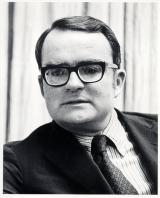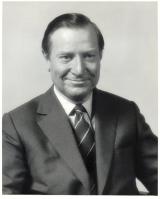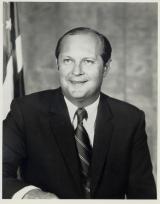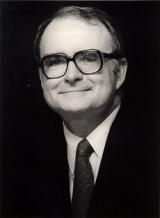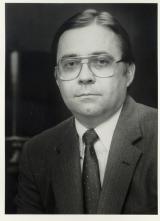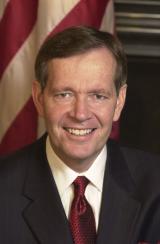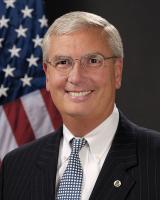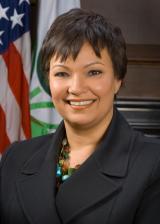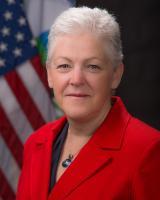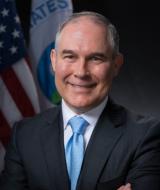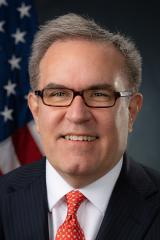EPA's Administrators
The head of EPA is the administrator, a cabinet-level political appointee nominated by the President and confirmed by the Senate. EPA's administrator is responsible for managing and enforcing the nation's environmental laws and regulations, preparing the annual budget of the agency, leading U.S. government efforts related to the environment at home and abroad, and other responsibilities.
Watch a special 50th anniversary video below, highlighting EPA's administrators from 1970 to present day as they talk about their tenure at the helm of the agency.
From its founding in 1970, EPA has had 15 confirmed administrators. Gaps in the tenure dates below reflect the assignment of an acting administrator.
- William D. Ruckelshaus, 1970 - 1973
- Russell E. Train, 1973 - 1977
- Douglas M. Costle, 1977 - 1981
- Anne M. Gorsuch [Burford], 1981 - 1983
- William D. Ruckelshaus, 1983 - 1985
- Lee M. Thomas, 1985 - 1989
- William K. Reilly, 1989 - 1993
- Carol M. Browner, 1993 - 2001
- Christine Todd Whitman, 2001 - 2003
- Michael O. Leavitt, 2003 - 2005
- Stephen L. Johnson, 2005 - 2009
- Lisa P. Jackson, 2009 - 2013
- Gina McCarthy, 2013 - 2017
- Scott Pruitt, 2017 - 2018
- Andrew Wheeler, 2019 - present
William D. Ruckelshaus
December 4, 1970 - April 30, 1973
Administrator Ruckelshaus served as the first EPA agency administrator, from December 1970 to April 1973. During EPA's formative years, he concentrated on:
- developing the new agency's organizational structure,
- enforcing against severely polluted cities and industrial polluters,
- setting health-based standards for air pollutants and standards for automobile emissions,
- requiring states to submit new air quality plans, and
- banning the general use of the pesticide DDT.
Russell E. Train
September 13, 1973 - January 20, 1977
Administrator Train served as the second EPA administrator, from September 1973 to January 1977. During this time, he supported:
- EPA's expansion of interest in international affairs,
- the approval of the catalytic converter to achieve Clean Air Act automobile emission reductions,
- the implementation of the Toxic Substances Control Act (TSCA) and the National Pollutant Discharge Elimination System (NPDES), and
- EPA's work to balance the demands of the energy crisis with environmental issues.
Douglas M. Costle
March 7, 1977 - January 20, 1981
Administrator Costle served as EPA's third administrator from 1977-1981. During his administration:
- he was faced with both the Love Canal disaster and the Three Mile Island nuclear accident, and
- one of the greatest landmarks of his administration was the Congressional creation of the Superfund cleanup program.
Anne M. Gorsuch [Burford]
May 20, 1981 - March 9, 1983
Administrator Gorsuch was the fourth administrator of EPA. During her administration:
- the Nuclear Waste Policy Act was signed into effect,
- schools began to be tested for the presence of asbestos, and
- the Valley of the Drums disaster occurred and dioxin contamination was discovered in Times Beach, Missouri.
William D. Ruckelshaus
May 18, 1983 - January 4, 1985
Administrator Ruckelshaus returned to EPA for a second term as EPA's fifth administrator. During his administration:
- he committed to open communications with the public through his "fishbowl" policy,
- he instituted an emergency ban of the pesticide ethylene dibromide (EDB), and
- started cleanups of pollution in the Chesapeake Bay.
Lee M. Thomas
February 8, 1985 - January 20, 1989
Lee Thomas served under President Ronald Reagan as EPA's sixth administrator. Under his leadership,
- the U.S. signed the Montreal Protocol, pledging to phase out the use of chlorofluorocarbons,
- passed rules to phase out lead additives from gasoline, and
- started emergency planning and community right-to-know programs.
Administrator Thomas also led a government-wide task force to coordinate the federal response to the Chernobyl nuclear disaster.
William K. Reilly
February 6, 1989 - January 20, 1993
Administrator Reilly served under President George H.W. Bush as EPA's seventh administrator. During his administration:
- he represented the United States at the Rio Earth Summit in 1992, and
- he was an instrumental figure in the Clean Air Act Amendments of 1990, which contained the first provisions to control acid rain.
Carol M. Browner
January 22, 1993 - January 19, 2001
Carol Browner served longer than any other EPA administrator, eight years, under President Bill Clinton. During her time as the eighth administrator, a wave of new regulation and programs were created, including:
- the Brownfields Program;
- the first refinery regulations;
- lead paint requirements; and
- new air quality standards.
Christine Todd Whitman
January 31, 2001 - June 27, 2003
- introduced the Clear Skies Initiative,
- established a watershed-based approach to protecting our nation's lakes, streams, and rivers, and
- saw the passage of landmark brownfields legislation that helped revitalize neighborhoods marred by abandoned industrial sites.
Whitman also oversaw the Hudson River clean-up and EPA's repsonse to the terrorist attacks of September 11, 2001.
Michael O. Leavitt
November 6, 2003 - January 25, 2005
Michael Leavitt became EPA's tenth administrator under President George W. Bush. During his administration:
- he implemented higher standards for ozone, diesel fuels and other air pollutants,
- organized and managed a collaboration to develop a federal plan to clean up the Great Lakes, and
- awarded grants to retrofit school buses under the Clean School Bus USA program. These school buses were fitted with emission control systems to reduce air pollution and protect children’s health.
Stephen L. Johnson
May 2, 2005 - January 20, 2009
When President George W. Bush named Stephen Johnson as EPA's eleventh administrator, Johnson became the first scientist and first career EPA employee to hold the position. During Johnson's tenure:
- EPA responded to the Hurricane Katrina disaster,
- created the WaterSense program, which promotes water-efficient products and services, and
- Johnson's EPA also cut pollution with stronger lead standards, a new rule for off-road diesel vehicles, and tougher standards for marine and locomotive diesel engines.
Lisa P. Jackson
January 26, 2009 - February 14, 2013
Serving under President Barack Obama as EPA's twelfth administrator, Lisa Jackson established as her priorities:
- taking action on climate change,
- improving air quality,
- assuring the safety of chemicals,
- cleaning up our communities,
- protecting America’s waters,
- expanding the conservation of environmentalism and working for environmental justice, and
- building strong state and tribal partnerships.
Gina McCarthy
July 19, 2013 - January 20, 2017
Serving under President Barack Obama, Administrator Gina McCarthy served as assistant administrator for EPA’s Office of Air and Radiation, then was appointed as EPA's thirteenth administrator. She established as her priorities:
- making a visible difference in communities across the country,
- addressing climate change and improving air quality,
- taking action on toxics and chemical safety,
- protecting water,
- launching a new era of state, tribal and local partnerships,
- embracing EPA as a high-performing organization, and
- working toward a sustainable future.
Scott Pruitt
February 17, 2017 - July 6, 2018
Scott Pruitt served as EPA's fourteenth administrator under President Donald Trump. He strongly believed that environmental law, policy and progress are all based on cooperation between the states, cooperation between the states and EPA, and cooperation between regulators and the public. During his administration:
- EPA established the Superfund Task Force to provide recommendations for improving and expediting cleanup and promoting redevelopment, and
- EPA also launched a broad effort to address PFAS contamination including identifying actions to support local communities, enhancing coordination with other partners, and increasing research.
Andrew Wheeler
February 28, 2019 - Present
On February 28, 2019, the U.S., Senate confirmed Andrew Wheeler as the fifteenth administrator of the Environmental Protection Agency. President Donald J. Trump had announced his appointment as the acting EPA administrator on July 5, 2018. Mr. Wheeler had previously been confirmed by the U.S. Senate as EPA deputy administrator on April 12, 2018.
Mr. Wheeler has dedicated his career to advancing sound environmental policies. As administrator, he has:
- fostered a cleaner, healthier environment,
- more effective partnerships, and
- greater certainty, compliance, and effectiveness.

